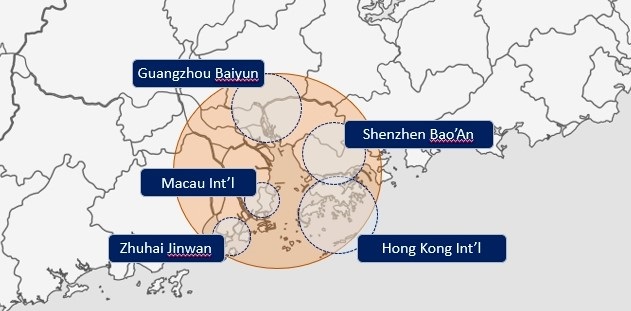


Competition has naturally intensified between five airports in the Greater Bay Area over the last several years , due to the their natural proximity ,with each airport taking steps to attract the same passenger traffic.
While Guangzhou, Shenzhen and Hong Kong are all three aiming to become major regional hubs , Macau and Zhuhai, with the smaller size of their operations and flights focused on South-East Asia, do not have similar ambition.
Inter-airport coordination within the Greater Bay Area has been the real challenge to manage the growth in air traffic efficiently .
And now, legislator Frankie Yick has asked a question related to the Co-operation between these five Airport in the Legislative Council today (April 27).
The all time question has been : Will all key stakeholders manage to define the fine line between competition and cooperation ?
His question was ,
It is learnt that currently, the five major airports in the Guangdong-Hong Kong-Macao Greater Bay Area (Greater Bay Area) (i.e. Hong Kong International Airport (HKIA), Guangzhou Baiyun International Airport (GBIA), Shenzhen Baoan International Airport (SBIA), Zhuhai Jinwan International Airport (Zhuhai Airport) and Macau International Airport) have overlapped among themselves in terms of flight destinations and sources of passengers.
In addition, GBIA and SBIA have been actively expanding their international routes in recent years and have gained, one after another, a place among the globe's busiest airports.
On the part of the reply , the Secretary for Transport and Housing, Mr Frank Chan Fan said ,
"Outline of the 14th Five-Year Plan for National Economic and Social Development of the People's Republic of China and the Long-Range Objectives Through the Year 2035" stated support for the enhancement of Hong Kong's status as an international aviation hub.
"Outline Development Plan for the Guangdong-Hong Kong-Macao Greater Bay Area" also clearly supported the consolidation of Hong Kong's status as an international aviation hub and suggested that airports in the Greater Bay Area (GBA) should pursue complementary development and healthy interactions, and build a world-class airport cluster.
Greater Bay Area’s situation is way different from cluster of airports co-existing in different continents , especially given its distinct territories, the similarities in terms of volume of traffic and geographical concentration of airports make it an interesting case study.
Intensifying competition will have a continuous presence, but cooperation opportunities among the airports need to be explored.
The rise in air traffic , specifically in a post pandemic scenario , over such a small geographical block brings about multiple inefficiencies and a range of complexities.
Routes are prime cause, the duplication of routes is a big drag to symbiotic existance , that brings about inefficiencies in terms of passenger load as well as fuel utilisation.
On any given day there can be a total of 68 flights for Bangkok departing from either Hong Kong, Guangzhou, Shenzhen or Macau. This should be brought forward for a discussion.
Secondly cause can be the departure time , with a mushrooming scene of aircraft in the airspace , the load to manage them increases , air traffic management becomes more complex, that can increase the risks of flight delays and incidents as well.
In order to succed and co-exist , the fine line needs to be respected amid right balance between promoting healthy competition and innovation, while at the same time enhancing cooperating and connectivity between airports.
Display Picture courtesy : Euromonitor International
